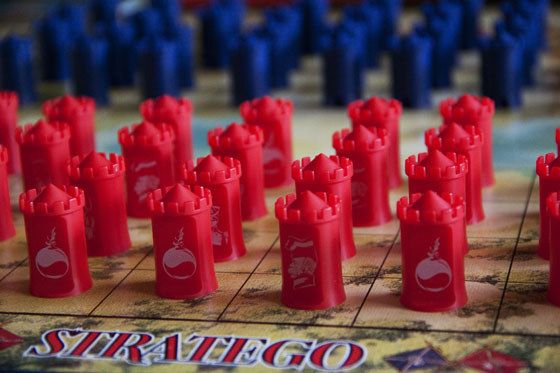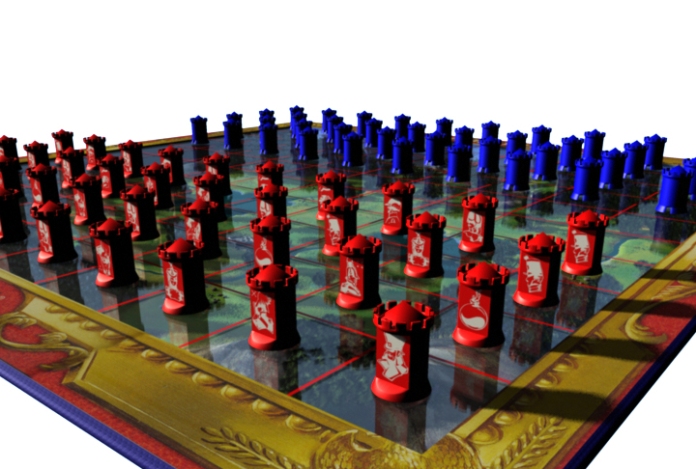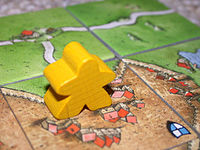This week we picked another board game to play and analyze. We chose Classic Stratego, I am not exactly sure which edition it was, but I think it was one from 1999 because the rulebook were copyrighted that year.

Game Overview
Stratego is a two player turn based strategy game where the objective is to capture the enemy flag. The board is divided into a 10×10 grid. The game has two phases, the first is the “setup phase” and the second is the “play phase”.
During the Setup phase a screen is placed at the middle two rows so the players cannot see the opponent’s side of the board. Each player put their pieces on their side of the board with the image on the piece facing them so that the opponent cannot see which unit is where when the screen is removed.
When all units have been placed on both sides the screen is removed and it is red’s turn to start. The players’ takes turn moving or attacking one unit at a time.
Each unit that can attack have a number associated with it, this is its strength. The units are:
1 – Spy – The spy is the weakest unit. It can only defeat the enemy Marshal (10), and then only if it is the spy attacking.
2 – Scout – The scouts can move any distance in one direction as it wish, as long as there is nothing in its way. It can also attack if there is an enemy at the end of that line.
3 – Miner (Sapper) – The miners are the only unit that can remove the bombs from the play field.
4 – Sergeant
5 – Lieutenant
6 – Captain
7 – Major
8 – Colonel
9 – General
10 – Marshal
Bomb – Cannot attack or move, but defeats all units attacking it, with the exception of the miner. It can only be removed by an enemy miner attacking it.
Flag – Cannot move or attack. The ones whose flag were captured by the enemy lose the game.
If one player tries to move a unit onto a tile that is already occupied by an enemy unit the moving unit is attacking. Both players reveal the units. The unit with the highest strength wins the battle and the other is removed from play. If both reveal the same strength they are both lost and removed. The game is won by either capturing the enemy flag or by defeating all enemy units that can move, whichever comes first.
The Best Sides of Stratego
What I like about Stratego is that you can never be sure about anything until there is a skirmish. With that I mean that unless there is a battle you can never know which enemy unit it is. The exception to this being if the enemy moves a piece more than one square in one goes, and then you know it is a scout. This makes you being on the edge every time you attack an unknown piece or if one attacks you.
Another thing is the amount of different ways, or strategies, you can have when placing your board. Where do you place your flag? In one of the corners or out on the field? Surrounded by bombs or alone? Each strategy has its strengths and weaknesses.
The Worst Sides of Stratego
This one is hard. I have not found anything I really dislike about Stratego. It wouldprobably be that if you play against the same player over and over again you will find out that he or she probably prefers a certain play style, for example how she places the flag and bombs, if it is an aggressive player of a defensive. But this does not really have anything to do with the actual game, so I probably should not take it up here under “The Worst”.
The only thing that they should have clarified more in the rules is if a bomb is removed or remains in play after it had been triggered. That is the only unclear thing I can find in the rules.

Our Experience
It was an easy game to learn. It is not so many rules and things were logical, for the exception of the bombs staying in play even after they had exploded. No were in the rules does it say if the bombs are removed or stays after a battle. The only thing it says is that if a Miner (3) attacks it, it is removed. We had to look it up on the internet were we found out that it remains until a Miner takes it out.
The first game we played took about 90 minutes to play. Both players played somewhat defensive and tried not to lose any units if possible. It were a lot of “cat and mouse” where one would chase the other unit, and then turn around when another, stronger unit came close, making the other player the chaser. Towards the end each player had about ten to fifteen units left when a Miner made its way to the other players wall of Bombs, disarmed one and captured the Flag behind, bringing the game to an end.
The second game was a lot faster. This one I played. I had placed my Flag in a corner, protected with two Bombs in either direction the opponent could come from. The rest of my units I had spread out evenly around the board with the Marshal (10) and the Spy (1) in the middle so they quickly could respond to the enemy Marshal if needed. What I did not expect was that my opponent would go full out attack, on the same side as my Flag. I did not have time or space to get my Marshal there in time. He broke through my defenses, bought with him a Miner (3), disarmed the Bomb and captured my Flag. The game took about 20 minutes, including the Setup.
There were several elements of both luck and skill involved in my opponent’s victory over me. Firstly, he was lucky that he chose to attack on the same side as my flag, because if he had chosen to attack on the other side or if I had placed my Flag there he would have had a much harder time winning because I had assassinated his Marshal with my Spy a couple of turns before. Another thing that I found out right after he had taken my Flag was that right next to my spy was his Flag, undefended. All I had to do was moving my Spy one step to the left and take it. He had placed his Marshal right next to it as its only defense, relying on that his offensive would take occupy me enough so that I would not have time to strike at him.
The third game it was my turn to be lucky. This time I faced one of the two that played the first game. This time I chose to have my flag in back row closer to the middle, defended by three bombs, one on either side. The match started and started attacking him in the middle and to the right. I sent in one unit at a time, Captains (6) and Lieutenants (5) mostly, penetrating deep into his territory before they came upon a bomb or a higher ranked unit. While I did this he attacked on the left and started killing of my stronger units. Suddenly, the game ended, one of my Captains (6) (I think it was) had captured the Flag. So, only by luck I had found and captured the Flag and ended the game after only 15 minutes. I did not expect that because his play style was one that makes for long games.
Our last game was played by the two that played the first match. This one took about one hour I think and played out mostly as the first one did with lots of thinking and moving forth and back, but also a lot of deceit. One player attacked with his Marshal (10) and the only 2 units that can take out the Marshal except the Bomb is the other Marshal and the Spy (1). So when the opponent started moving another unit, from pretty far away towards the Marshal, the Marshal player thought it had to be the Spy so retreated with him, only to find out, a bit later when he could take it, that it was in fact a Sergeant (4). And now the really interesting things started. Both tried to fake the other player into believing that the unknown units were something else. For example only moving the Scouts (2) one tile at a time until it was lined up so it could make a straight move and attack what he thought was the enemy Spy, only to find out that it was not a Spy, but something else. Eventually one player got a Miner (3) behind enemy lines and succeeded in capturing the Flag.
Target Audience for Stratego
The box says “From eight years and up” and I think that could work fine. It is not many rules to keep in mind but I would guess that a game between two eight years old would be pretty straight forward – full out attack. To get the full experience of Stratego I would suggest the players to be at least eleven or twelve years.
I think it is a great game for everyone that enjoys a good time with a friend or family member. It works well for old as well as for young.
Well, that’s it for me this time. We will see if it will be another board game that I will analyze next or if it will be a roleplaying game. The instructions are pretty confusing at the moment, with teachers saying one thing and the course side another 🙂

